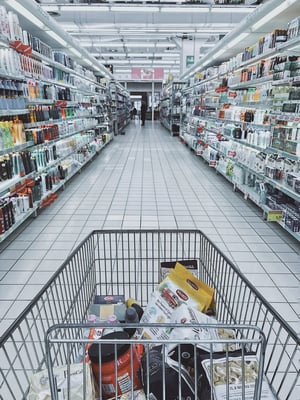Artificial intelligence in its many forms is showing a huge impact on the retail industry. Today, this technology is already empowering merchandisers to tailor the shopper experience around real, authentic data while simultaneously helping them responsibly manage their inventories. In this blog post, I’ll share four ways merchandisers today are already using image recognition to directly impact sales.
More Effective Store Planning
 Developing store flow and shelving plans are tasks that can now be done in conjunction with AI using real-time insights from security camera feeds. We all know that those cameras located in every store are used to help loss prevention. However, they hold inside of them a treasure trove a data. Using computer vision like Clarifai, AI can monitor foot traffic to measure shopper behaviors like dwell time in front of displays.
Developing store flow and shelving plans are tasks that can now be done in conjunction with AI using real-time insights from security camera feeds. We all know that those cameras located in every store are used to help loss prevention. However, they hold inside of them a treasure trove a data. Using computer vision like Clarifai, AI can monitor foot traffic to measure shopper behaviors like dwell time in front of displays.
Manage Stock in Real Time
Tracking daily inventory can be a time-consuming task AI can help augment - enabling merchandisers to focus on more complex tasks and questions than how much of a product is on the store floor. How is this accomplished? Similar to store planning, retailers are turning to the data in security camera footage to literally see when items are running low and to make smarter and faster inventory decisions with that information.
Real-Time Trend Predictions
 Retailers already use information on trends from major weather changes to shifts in fashion to make inventory and display decisions. However, there is now an opportunity to truly understand consumer desires with social media data. For example, social-listening platform Pulsar compared the Fashion Week trends predicted by experts at Vogue Magazine and their own predictions using social media posts made during the events and found a few discrepancies in what fashion experts saw as key trends and what consumers were actually wearing.
Retailers already use information on trends from major weather changes to shifts in fashion to make inventory and display decisions. However, there is now an opportunity to truly understand consumer desires with social media data. For example, social-listening platform Pulsar compared the Fashion Week trends predicted by experts at Vogue Magazine and their own predictions using social media posts made during the events and found a few discrepancies in what fashion experts saw as key trends and what consumers were actually wearing.
How did they do it? Pulsar used Clarifai’s computer vision technology, specifically our apparel model, to analyze the Fashion Week content shared in 2018. With AI, they were able to analyze over 1 million Twitter and Instagram posts with the #fashionweek hashtag, and then narrow their focus to posts hashtagged #fashionblogger (over 400,000) and #streetstyle (just under 200,000.) Without AI, the team would have likely missed the majority of such posts, making for a far less comprehensive study.
Optimizing Online Inventory
 E-commerce stores like Staples often rely on organic search traffic to its products to drive sales and revenue. There are many ways to improve organic search engine results, one of which is optimizing images for SEO. This includes writing descriptive keywords (ALT text) in the image tags. However, this practice can be tricky to execute when you’re optimizing hundreds to thousands of images for multiple languages. Staples used computer vision (specifically, the Clarifai API’s multi-language feature, which recognizes more than 11,000 different concepts in images in over twenty languages) to append the ALT tags of over 600 products to boost SEO – saving five figures worth in agency costs in the process.
E-commerce stores like Staples often rely on organic search traffic to its products to drive sales and revenue. There are many ways to improve organic search engine results, one of which is optimizing images for SEO. This includes writing descriptive keywords (ALT text) in the image tags. However, this practice can be tricky to execute when you’re optimizing hundreds to thousands of images for multiple languages. Staples used computer vision (specifically, the Clarifai API’s multi-language feature, which recognizes more than 11,000 different concepts in images in over twenty languages) to append the ALT tags of over 600 products to boost SEO – saving five figures worth in agency costs in the process.



